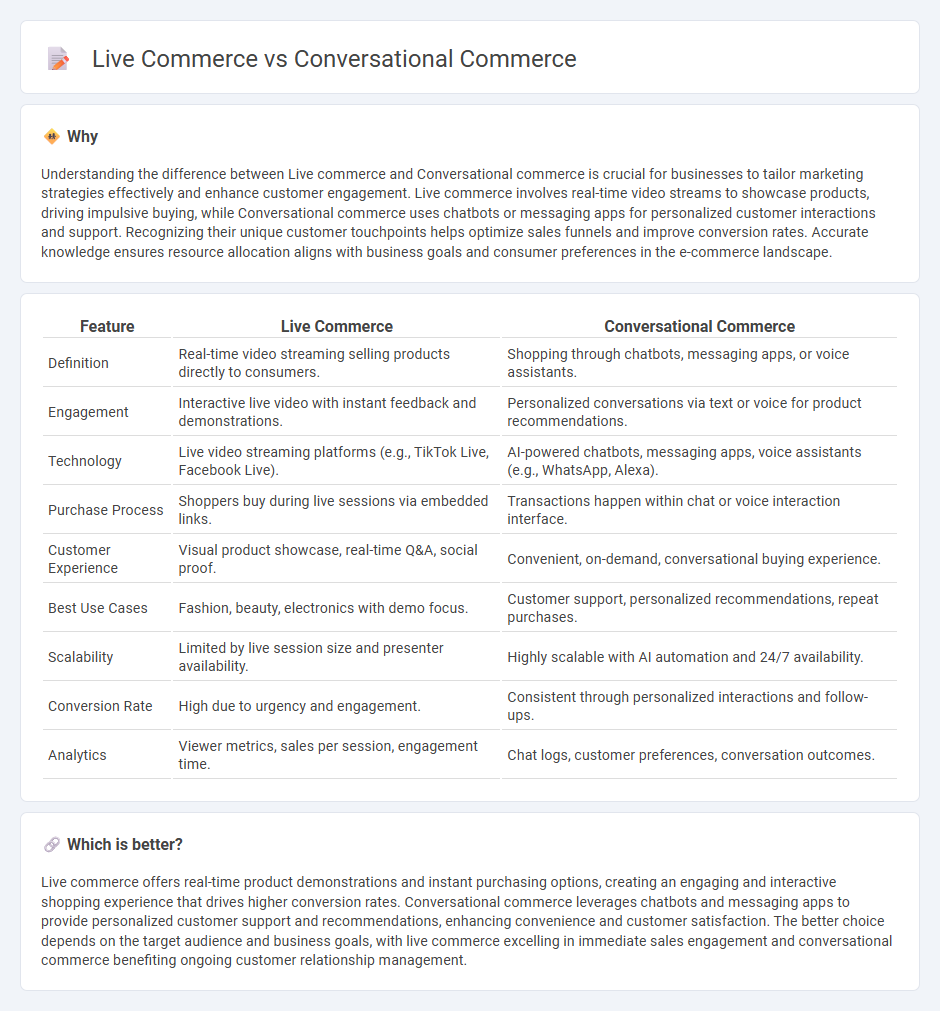
Live commerce combines real-time video streaming with online shopping, enabling customers to view products and make purchases instantly during interactive broadcasts. Conversational commerce leverages AI-driven chatbots and messaging platforms to facilitate personalized shopping experiences through direct communication. Explore how these innovative commerce models are transforming the digital retail landscape.
Why it is important
Understanding the difference between Live commerce and Conversational commerce is crucial for businesses to tailor marketing strategies effectively and enhance customer engagement. Live commerce involves real-time video streams to showcase products, driving impulsive buying, while Conversational commerce uses chatbots or messaging apps for personalized customer interactions and support. Recognizing their unique customer touchpoints helps optimize sales funnels and improve conversion rates. Accurate knowledge ensures resource allocation aligns with business goals and consumer preferences in the e-commerce landscape.
Comparison Table
| Feature | Live Commerce | Conversational Commerce |
|---|---|---|
| Definition | Real-time video streaming selling products directly to consumers. | Shopping through chatbots, messaging apps, or voice assistants. |
| Engagement | Interactive live video with instant feedback and demonstrations. | Personalized conversations via text or voice for product recommendations. |
| Technology | Live video streaming platforms (e.g., TikTok Live, Facebook Live). | AI-powered chatbots, messaging apps, voice assistants (e.g., WhatsApp, Alexa). |
| Purchase Process | Shoppers buy during live sessions via embedded links. | Transactions happen within chat or voice interaction interface. |
| Customer Experience | Visual product showcase, real-time Q&A, social proof. | Convenient, on-demand, conversational buying experience. |
| Best Use Cases | Fashion, beauty, electronics with demo focus. | Customer support, personalized recommendations, repeat purchases. |
| Scalability | Limited by live session size and presenter availability. | Highly scalable with AI automation and 24/7 availability. |
| Conversion Rate | High due to urgency and engagement. | Consistent through personalized interactions and follow-ups. |
| Analytics | Viewer metrics, sales per session, engagement time. | Chat logs, customer preferences, conversation outcomes. |
Which is better?
Live commerce offers real-time product demonstrations and instant purchasing options, creating an engaging and interactive shopping experience that drives higher conversion rates. Conversational commerce leverages chatbots and messaging apps to provide personalized customer support and recommendations, enhancing convenience and customer satisfaction. The better choice depends on the target audience and business goals, with live commerce excelling in immediate sales engagement and conversational commerce benefiting ongoing customer relationship management.
Connection
Live commerce integrates real-time video streaming with e-commerce, allowing customers to interact and purchase products instantly, while conversational commerce uses AI-driven chatbots and messaging platforms to facilitate personalized shopping experiences. Both leverage interactive technology to enhance customer engagement and streamline the purchasing process. Together, they create a seamless, immersive shopping environment that drives higher conversion rates and boosts online sales.
Key Terms
Chatbots (Conversational commerce)
Conversational commerce leverages AI-powered chatbots to facilitate personalized, real-time customer interactions and seamless transactions within messaging apps and social platforms. Live commerce integrates live video streaming with instant purchasing options, creating an immersive shopping experience with influencer or host engagement. Discover how chatbot-driven conversational commerce transforms customer engagement and boosts sales by exploring its advanced capabilities.
Livestreaming (Live commerce)
Livestreaming in live commerce leverages real-time video interactions to create an immersive shopping experience, boosting customer engagement and conversion rates significantly. Conversational commerce, by contrast, revolves around chat-based interactions, often using AI-driven chatbots to facilitate seamless purchasing through messaging platforms. Discover how livestreaming is revolutionizing retail by blending entertainment with instant buying options.
Real-time engagement
Conversational commerce leverages chatbots and messaging apps to facilitate personalized shopping through real-time interactions, enhancing customer experience and boosting conversion rates. Live commerce integrates live streaming with instant purchasing options, creating immersive shopping events that drive urgency and engagement among viewers. Discover how these innovative strategies transform digital retail by exploring their real-time engagement benefits.
Source and External Links
What is Conversational Commerce? | CM.com Glossary - Conversational commerce enables consumers to shop and communicate with brands through messaging channels, voice, and chat, allowing the entire purchase process within the same messaging platform like WhatsApp, Facebook Messenger, or SMS.
What Is Conversational Commerce? Definition and Guide - Conversational commerce uses chatbots, messaging apps, and voice assistants to provide personalized recommendations and streamline the shopping process by enabling consumers to interact with businesses in real time via natural conversations within messaging apps.
What is conversational commerce? Examples, types, + ... - It involves various customer touchpoints such as proactive chat on websites, click-to-message ads, and transactions through third-party messaging apps like WhatsApp or WeChat, enhancing customer engagement and conversion through personalized, interactive communication.
 dowidth.com
dowidth.com